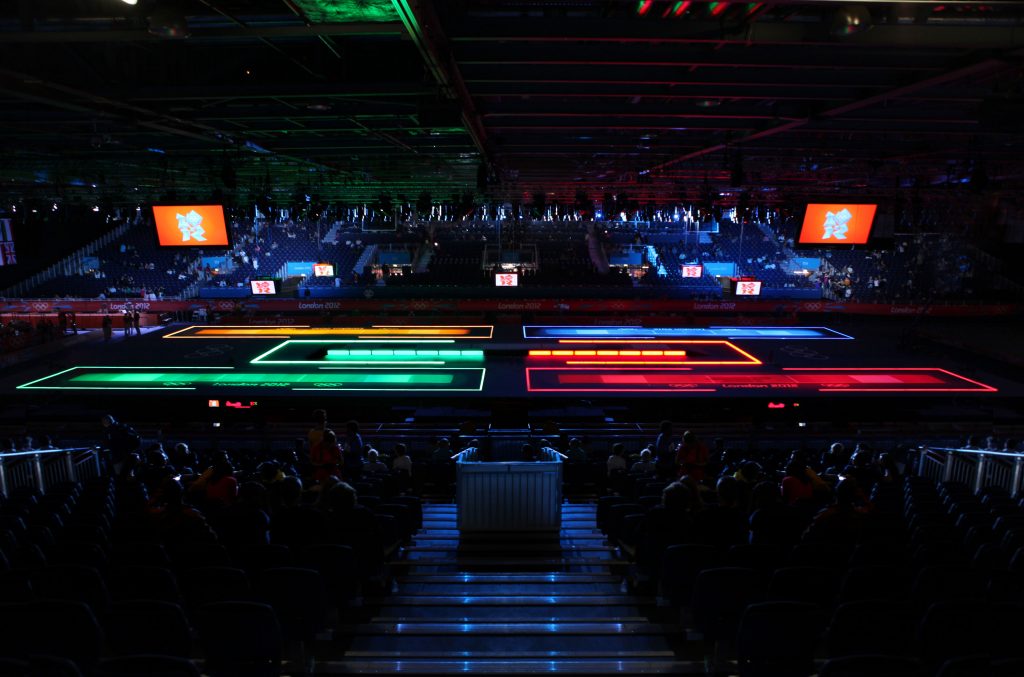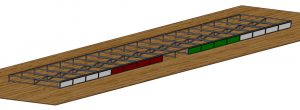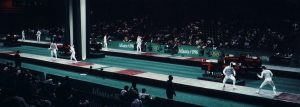We use cookies
Using our site means you agree to the use of cookies and similar technologies. Read about our policy and how to disable them here
 London 2012 olympic fencing venue
Every time Leon Paul have provided equipment for an Olympic games we have created design that has gone on to become the standard for high level fencing presentation. In 1996 for the Atlanta Olympics we invented the sectional metal piste that has been used ever since as the standard piste used at all major fencing events. In London we made a spectacular yet versatile lighting set up that could be moved from venue to venue easily. The design was so good that is still being used 4 years later at the Rio Olympics. It is great for me to see British design and British made equipment being used worldwide for multiple Olympics.
For Tokyo I think we need something new and we need to evolve the technology. So what's next for fencing arenas, presentations and pistes? Here are my thoughts.
Glass floors and not ceilings
U shaped Static lights surrounding a piste make the overall stage set up even bigger (50 meters for a 5 piste layout!) and this pushes the audience further from the action. If we can integrate the lighting into the piste we can help keep venues small and intimate.
How do we do this? In squash they use glass courts with glass walls for obvious reasons but the same glass is so strong that it could easily withstand the blow of a sword. This would mean that a glass transparent floor could be laid over LED lighting screens or panels. This is how Nike were able to make this amazing basketball court below.
https://www.youtube.com/watch?v=u2YhDQtncK8
But how do you make glass conductive….
Well a new material called graphene is transparent and conductive so a layer of this applied to the surface would solve all the issues. The screens below the glass would sit inside a standard raised piste so the piste would sit of the floor with all the lighting housed underneath.
London 2012 olympic fencing venue
Every time Leon Paul have provided equipment for an Olympic games we have created design that has gone on to become the standard for high level fencing presentation. In 1996 for the Atlanta Olympics we invented the sectional metal piste that has been used ever since as the standard piste used at all major fencing events. In London we made a spectacular yet versatile lighting set up that could be moved from venue to venue easily. The design was so good that is still being used 4 years later at the Rio Olympics. It is great for me to see British design and British made equipment being used worldwide for multiple Olympics.
For Tokyo I think we need something new and we need to evolve the technology. So what's next for fencing arenas, presentations and pistes? Here are my thoughts.
Glass floors and not ceilings
U shaped Static lights surrounding a piste make the overall stage set up even bigger (50 meters for a 5 piste layout!) and this pushes the audience further from the action. If we can integrate the lighting into the piste we can help keep venues small and intimate.
How do we do this? In squash they use glass courts with glass walls for obvious reasons but the same glass is so strong that it could easily withstand the blow of a sword. This would mean that a glass transparent floor could be laid over LED lighting screens or panels. This is how Nike were able to make this amazing basketball court below.
https://www.youtube.com/watch?v=u2YhDQtncK8
But how do you make glass conductive….
Well a new material called graphene is transparent and conductive so a layer of this applied to the surface would solve all the issues. The screens below the glass would sit inside a standard raised piste so the piste would sit of the floor with all the lighting housed underneath.

 Cameras or other motion tracking technology could then communicate that information to computers running software to control the piste. As a player moved from side to side, a floor spotlight could track them or even their feet. This would make a piste that can interact spectacularly with the fencers movements or hits.
Interaction not just reaction
Using a wireless signal from the scoring apparatus it is possible to send live signals from the scoring equipment to spectators. This could be used to connect to a simple fencing app that would show information on the fencer. For example fencers speed, distance covered, remaining time and finally when a hit is scored flash the colour on the screen and make a sound. This would make the whole arena light up from the stands with colour and sound provided enough spectators had the app and the phone out.
Cameras or other motion tracking technology could then communicate that information to computers running software to control the piste. As a player moved from side to side, a floor spotlight could track them or even their feet. This would make a piste that can interact spectacularly with the fencers movements or hits.
Interaction not just reaction
Using a wireless signal from the scoring apparatus it is possible to send live signals from the scoring equipment to spectators. This could be used to connect to a simple fencing app that would show information on the fencer. For example fencers speed, distance covered, remaining time and finally when a hit is scored flash the colour on the screen and make a sound. This would make the whole arena light up from the stands with colour and sound provided enough spectators had the app and the phone out.
 Listen to the man
Lastly I think we all need to get behind Yuki Ota and his amazing program for the future of fencing. If you have not seen it… check this out:
https://www.youtube.com/watch?v=leOP7rWwBpw
Listen to the man
Lastly I think we all need to get behind Yuki Ota and his amazing program for the future of fencing. If you have not seen it… check this out:
https://www.youtube.com/watch?v=leOP7rWwBpw

